What is Nasal Cavity? Amazing Fun Facts about Nasal Cavity, Diseases, Function & Anatomy
- Is it nasal cavity or cavities?
- Who are compulsive nose breathers?
- Is your nose also an excretory organ?
- How your nose acts as an olfactory organ?
In addition to getting comprehensive answers to all these questions, here you will also learn about the structure, anatomy and functions of the nasal cavity.Lots of interesting facts about nose and nasal cavity are also given. Just read on to discover amazing realities about the nasal passage.
What is Nasal Cavity?
In addition to being an integral part of the respiratory system, your nose also serves as the organ of olfaction or smell. In other words, the mechanisms of both the breathing and olfaction begin with nose. It also gives shape and adds to the beauty of your face.
Consisting of a large irregular chamber, your nasal cavity is the main route of air entry. Along with the nose, paranasal sinuses and nasolacrimal duct, the nasal cavity forms the nasal passage or proximal part of the respiratory system. The other parts of the respiratory system include the pharynx, the larynx, trachea, bronchi (two), bronchioles, lungs (two) and the coverings of the lungs, called pleura.
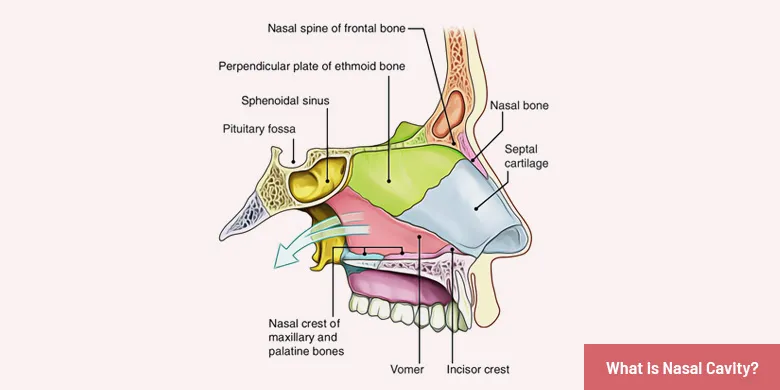
Fig. 1: What is Nasal Cavity
Nasal Cavity Functions
Apart from serving as a respiratory and sensory (olfactory) organ, the nose also performs several other jobs, like filtering, cleaning, warming and moistening of air. It also disposes of foreign debris extracted from inhalations.Smell is detected by nerve endings located in the roof of the nasal cavity. The airborne odours stimulate these nerve endings and the olfactory nerves carry the signals to the brain for the perception of the sense of smell.
The inhaled air is likely to contain dirt, germs and other harmful substances which may cause serious damage to your lungs (the major respiratory organs). The cilia or hair-like growths filter and clean the air by trapping and removing these substances. For their removal out of the body, the trapped particles are expelled upward along the lumen of the respiratory passageway.
The cilia in the respiratory tract move the mucus upward toward your nose. It is then removed out of the body when you sneeze or it my be coughed out.
The respiratory tract begins at the level of nose or mouth and moves downward to reach the lungs. During the process of inhalation, air passes through the nasal cavity, pharynx, larynx and trachea, where it gets warmed and moistened.
The irregular chamber of nasal cavity is divided by a septum into two equal passages or cavities. Anteriorly, the septum consists of hyaline cartilage and, posteriorly, it is formed by the perpendicular plate of ethmoid bone and vomer.
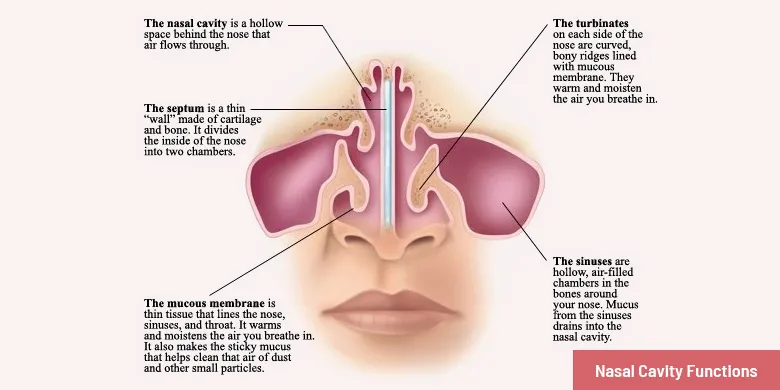
Fig. 2: Nasal Cavity Functions
Nasal Cavity or Cavities
Do you have two nasal cavities or just one with two chambers? Waugh et al. (2010), in their book “Ross &Wilson Anatomy and Physiology in Health and Illness” describe the nose as havingan irregular chamber, called nasal cavity, divided into two equal passages by a septum (called the nasal septum).
However, Finucane et al. (2003), in the book “Principals of Airway Management” are of the view that the nose has two nasal cavities (right and left), separated be the nasal septum.
Nasal Cavity Anatomy
The nose looks likea pyramidal-shaped structure which projects from the midface and is made up of the bone, the mucous membrane, the fibrofatty tissues, the cartilage and the skin. Two apertures, called anterior nares, are located in the inferior portion of the nose. The choanae are the posterior portions of the anterior nares which open into the nasopharynx (the part of the pharynx connected with the nasal cavity).
In the congenital anomaly, called choanal atresia, one or both of the apertures (anterior nares or nostrils) are absent by birth.The infants born with this condition are the compulsive nose breathers and they are at the risk of suffocation.In this case, the infants need urgent surgical correction of choanal atresia soon after the birth.
Anatomically, each nasal cavity has a roof, a floor and medial and lateral walls. Each of these cavities opens to the exterior through the nasal opening or nostril. The medial wall of each cavity is formed by the nasal septum. The nasal septum is composed of the septal cartilage and perpendicular plates of vomer and ethmoid bones .The lateral walls, on the other hand, have got a bony framework. Attached to this bony framework are three bony projections, called the turbinates or conchae.
The inferior concha is a separate structure while the middle and upper conchae are derived from the medial aspect of the ethmoid bone.A number of openings present in the lateral nasal walls developcommunication links with the nasal sinuses and the nasolacrimal duct.
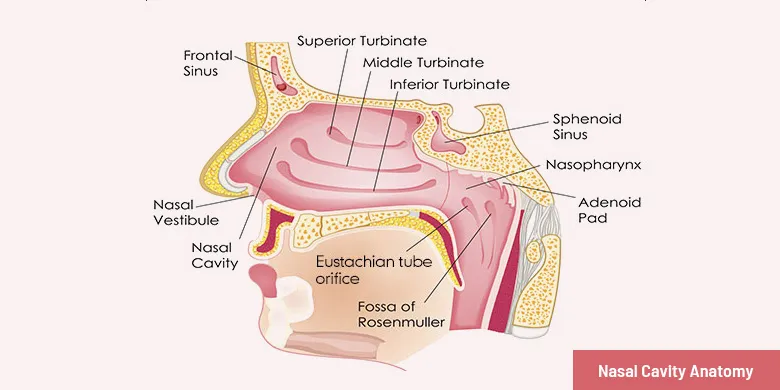
Fig. 3: Nasal Cavity Anatomy
In their book “Ross & Wilson Anatomy and Physiology in Health and Illness”, Waugh et al. (2010) give description of different parts of the nasal cavity as under:
Nasal Roof:
The roof of the nasal cavity is composed of the cribriform plate of the ethmoid bone and the sphenoid bone along with the nasal bones and the frontal bone.
Nasal floor:
Formed by the roof of the mouth, the floor of the nasal cavity consists of the soft palate behind and the hard palate in front. While the soft palate is composed of involuntary muscle, the hard palate consists of the maxilla and the palatine bones.
Medial Nasal Wall:
The medial wall of the nose consists of the nasal septum which separates the right nasal cavity from the left one.
Lateral Nasal Walls:
The lateral walls of the nose have bony framework. They are formed by the ethmoid bone, the inferior conchae and the maxilla.
Posterior Nasal Walls:
The posterior wall of the pharynx (or pharyngeal cavity) forms the posterior nasal walls.
Nasal Cavity Disease
The nasal disorders include rhinolith, nasal myiasis, nasal synechia and choanal atresia. Rhinolith refers to the stone formation in the nose. It usually forms around the nucleus of a small exogenous foreign body, blood clot or the inspissated secretions in the nose by slow deposition of magnesium and calcium salts.
Occasionally, a rhinolith may grow into a large, irregular mass and fill the nasal cavity. It may lead to the pressure necrosis of the septum and lateral nasal walls.Most of the rhinoliths can be removed through the anterior nares or nostrils under general anesthesia.
The condition of nasal myiasis is also commonly known as “Maggots in Nose”. In this disease, the larval forms of flies infest the nose, the paranasal sinuses and nasopharynx, and cause extensive destruction. Nasal synechia refers to the adhesion formation between the nasal septum and turbinates.
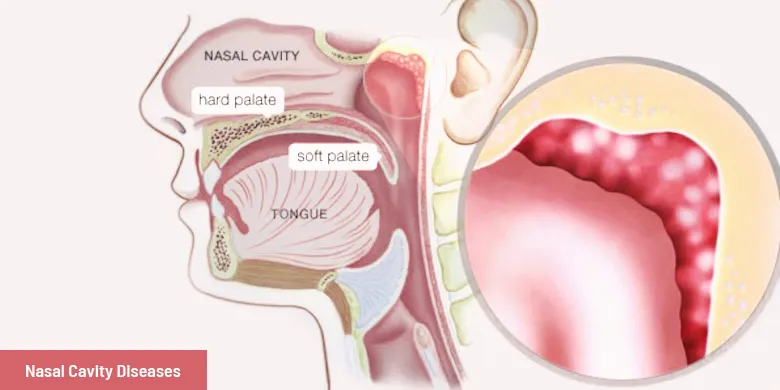
Fig. 4: Nasal Cavity Disease
Nasal Cavity Fun Facts
- The nasal cavity is just like a little cave located behind the nose.
- Your nose is part of several body systems at the same time.
- In addition to serving in the capacity of a respiratory organ, the nasal cavity also performs several other important jobs, like olfaction, filtration, humidification and temporary storage of secretions from the paranasal sinuses and the nasolacrimal ducts.
- As an excretory organ, it helps in the excretion of carbon dioxide and trapped substances in the respiratory tract.
- Do you know the development of the nasal cavity starts in the 32-day (5mm) embryo? During the development, the frontal process, called olfactory placode, is thickened.
- The compulsive nose breathers at birth are the infants born with the condition of choanal atresia in which anterior nares (apertures) are absent.
- Forcing endotracheal tubes into the nasal cavity can inflict considerable damage on the lateral walls of the nose. It may also cause disruption of the conchae.
- Your seemingly fragile nasal septum is made up of septal cartilage and two bones, called vomer and ethmoid.
- Both the nasal cavities are coated by a thick sticky substance, called mucous, which helps in trapping the dirt particles and germs.
- The cilia or tiny hair line the lumen of the nasal passage and keep the mucous (thick, sticky substance) moving.
- Do you know the winding path of the nose helps trap the dust, and other harmful substances, so they don’t travel to the lungs?
- The part of the pharynx connected with the nasal cavity is called nasopharynx.
- What is the common name of the anterior nares? They are called nostrils which serve as opening from exterior into the nasal cavity.
- The nostrils contain nasal hairs which are coated in sticky mucous.
- In nasal myiasis, a condition of the nasal cavity, maggots or larvae of flies can be seen in the nose.
- CSF Rhinorrhoea is a nasal disorder which involves the leakage of the cerebrospinal fluid (CSF) into the nasal cavity. The fluid may be clear or mixed with blood (for example, in case of acute head injuries).
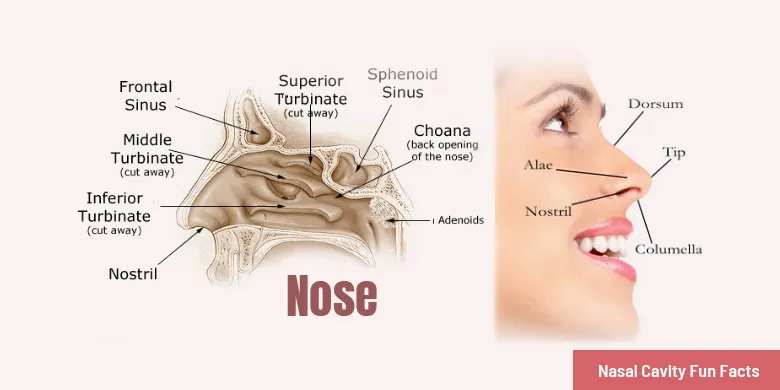
Fig. 5: Nasal Cavity Fun Facts
References:
- Waugh, A., & Grant, A. (2010). Ross & Wilson Anatomy and Physiology in Health and Illness E-Book. Elsevier Health Sciences.
- Lang, J. (1989). Clinical anatomy of the nose, nasal cavity and paranasal sinuses. Thieme.
- Brett, F. (2015). Your respiratory system works. North Mankato, Minnesota: Capstone Press, a Capstone imprint.
- 4. Finucane, B. T., & Santora, A. H. (2003). Principles of airway management.
- 5. Olien, R. (2006). The respiratory system. Mankato, Minn: Capstone Press.
- 6. Dhingra, P. L., & Dhingra, S. (2014). Diseases of Ear, Nose and Throat-E-Book. Elsevier Health Sciences.


